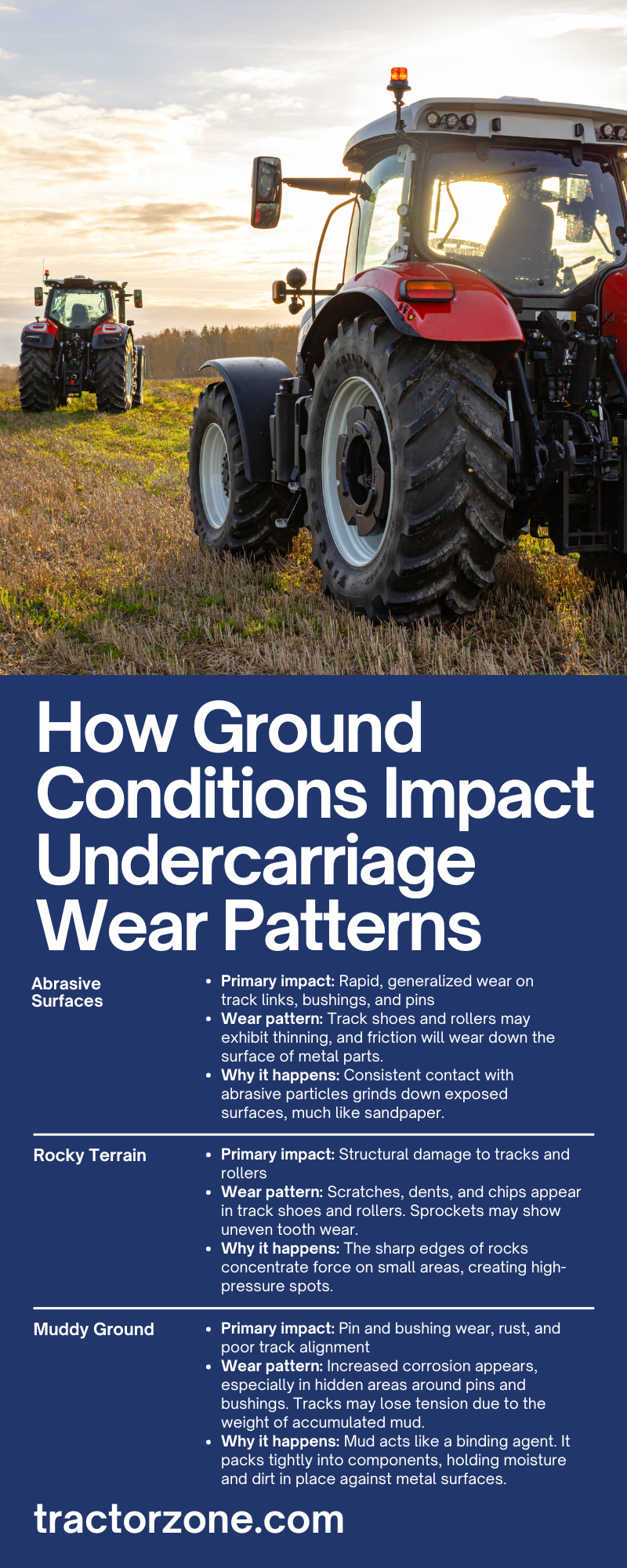How Ground Conditions Impact Undercarriage Wear Patterns
Apr 3rd 2025
As a heavy equipment operator, you should know how crucial the undercarriage is for keeping your machine running smoothly. It carries the weight of the equipment and provides traction and stability on challenging terrains. While regular wear and tear are inevitable, one major factor that significantly contributes to undercarriage wear patterns is the ground condition you operate on.
Understanding how ground conditions impact undercarriage wear patterns is essential for equipment operators aiming to maximize efficiency, reduce maintenance costs, and keep their machinery in top condition. This blog explores the relationship between ground conditions and undercarriage wear, offering insights on how to identify wear patterns and mitigate damage.
To understand how ground conditions affect your machine, it’s important to first know the components of an undercarriage. By breaking down the system, you’ll see how each part is exposed to wear based on the equipment’s operation.
These elements work as the backbone of the undercarriage, connecting the tracks and enabling smooth movement. Wear on pins and bushings can lead to reduced flexibility in the tracks, impacting overall performance.
Track shoes directly contact the ground. They are exposed to constant abrasion and must be tough enough to handle the surface stress without cracking or wearing away too quickly.
Track guards help keep the tracks aligned and in place. They also protect the system from debris or obstacles on rough terrain.
Rollers keep the tracks moving evenly, while sprockets drive the tracks using mechanical force. Idlers manage tension to prevent the tracks from loosening or slipping. These parts work in sync but can wear unevenly based on the type of surface pressure they endure.
Knowing how these components work together makes it easier to diagnose wear and identify areas that might be heavily impacted by different ground conditions.
Ground conditions refer to the attributes of the surface where heavy machinery operates. These attributes include slope, firmness, moisture content, chemical composition, and compaction level. Stable ground conditions determine the machinery's ability to function efficiently, while unstable ground can lead to serious operational issues.
Stable ground conditions are crucial for worksite safety, which is why OSHA has standards related to surface conditions. Properly prepared and compacted surfaces can safely support heavy equipment weight, lowering the risk of ground instability and accidents.
Operators regularly face a variety of terrains, each presenting its own challenges. Here are some of the most common surface conditions:
By understanding these conditions, operators can better predict the impact on their machines.
The type of wear the undercarriage experiences largely depends on the environment. Here’s how the ground conditions at a given worksite typically translate into wear patterns.
Working in environments with abrasive surfaces made of sand, rocks, and gravel can cause widespread wear.
Operating on this type of terrain can turn rocks into small projectiles that hit the undercarriage.
Mud can cake onto undercarriage components, making it more difficult to spot wear.
Working on clay and frozen ground can create serious structural problems within the undercarriage.
By recognizing these patterns early, you can take preventive measures before they turn into major problems.
Recognizing wear patterns early is critical to extending the life of your machine. Operators can use the following techniques to identify and address issues before they escalate.
Operators should regularly inspect the undercarriage for signs of excessive wear, cracks, rust, or debris buildup. Paying close attention to frequently worn parts, such as pins, rollers, and sprockets, can help you spot damage before major failures occur.
Precise measurements of track pins and bushings can reveal gradual wear and tear. For example, checking the pin diameter regularly could help you identify when replacement is necessary, preventing larger issues. Checking track tension can also help you identify excessive wear in the pins and bushings.
Modern diagnostic tools use sensors and software to analyze usage data, track wear rates, and predict future maintenance needs. This allows operators to plan repairs or part replacements proactively, avoiding downtime.
While ground conditions can’t always be controlled, operators can take steps to reduce their impact. Adopting these best practices ensures equipment longevity and improves overall efficiency.
Evaluate the jobsite, then choose machines that can handle those surfaces. For example, steel tracks designed for gravel may not perform well in muddy conditions. Ensuring compatibility can make a significant difference.
Adding wear plates, track guards, or specialized shoes tailored to certain terrains protects vulnerable parts and minimizes wear. Adjusting track tension depending on the ground conditions can also improve traction and prolong the life of the undercarriage. Such modifications are cost-effective in the long term.
Operators should avoid sudden, aggressive maneuvers that strain the undercarriage. Training personnel to adapt to ground conditions, such as reducing speed on muddy surfaces, will improve equipment performance and prevent premature wear.
Clean out mud, debris, and chemical residues from the undercarriage after shifts. Lubricate moving parts to prevent rust, and keep an eye on tension adjustments to maintain track alignment.
Understanding how ground conditions impact undercarriage wear patterns can save you time and money. Whether you’re dealing with sand or mud, tailoring your maintenance strategies to the surface conditions at your worksite are key to extending the life of your machine. If you’re looking for replacement undercarriage parts for sale or want more general advice on maintenance, reach out to the experts at Tractor Zone today.
